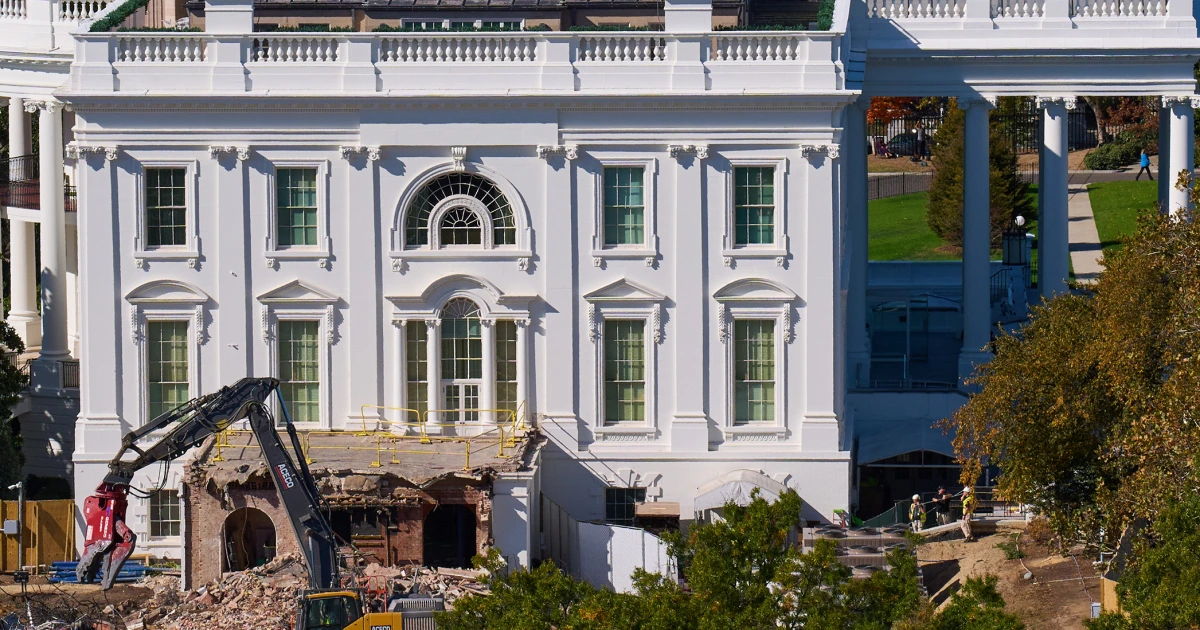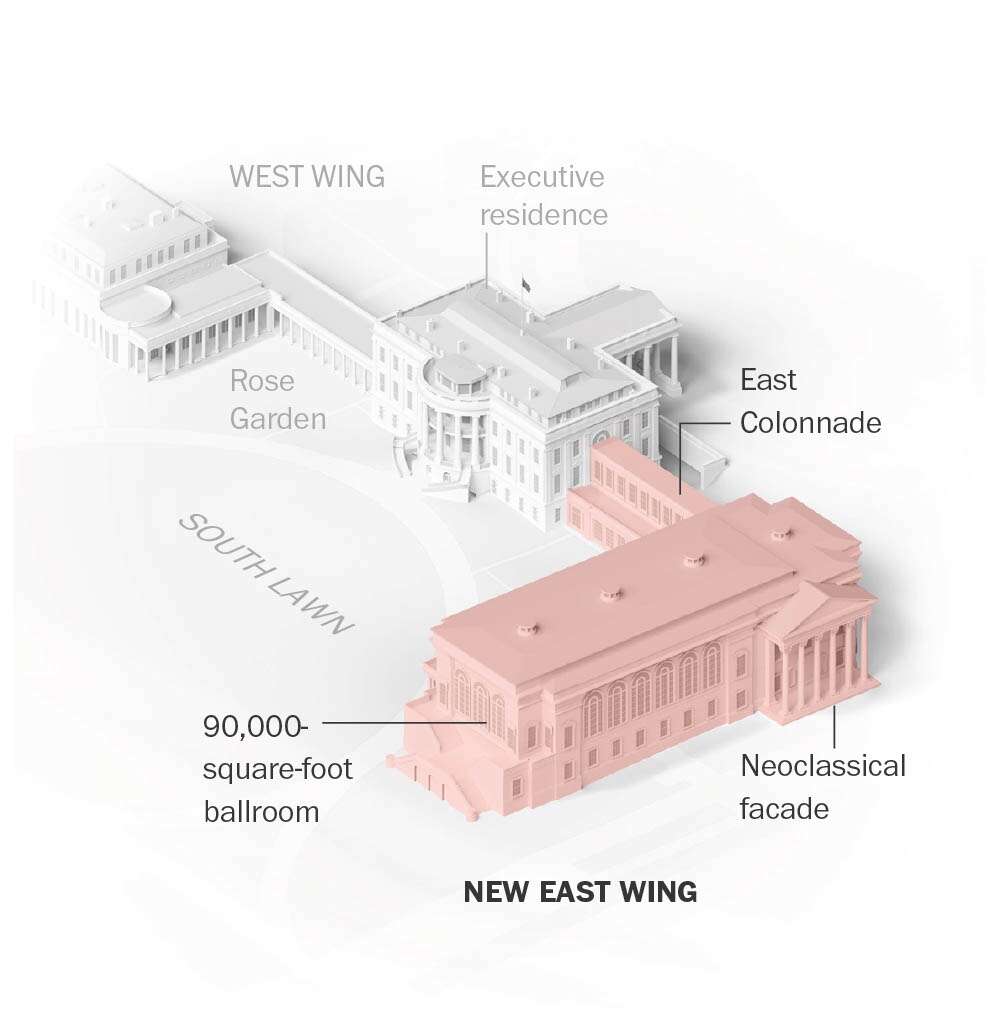Fresh tensions erupt in Washington today as President Donald Trump pushes forward with his grand vision for a sprawling White House ballroom. The project, now estimated at $300 million, has ignited a fierce standoff between Trump and renowned architect James C. McCrery II.
Sources close to the discussions reveal McCrery urged scaling back the 90,000-square-foot design to preserve the historic balance of the White House grounds. Trump, undeterred, insists on a structure that eclipses the existing 55,000-square-foot residence, calling it essential for modern statecraft. This clash underscores the high drama of blending presidential ambition with architectural restraint, all while the nation grapples with tightening budgets and rising costs.
White House spokespeople frame the back-and-forth as routine collaboration between client and creator. Yet the stakes feel profoundly personal for taxpayers watching federal dollars stretch thin. The East Wing demolition kicked off last month, paving the way for this opulent addition that promises to redefine White House entertaining.
Critics whisper of excess in an era of economic strain, but supporters hail it as a bold upgrade long overdue. As crews clear rubble under crisp November skies, the debate rages on, pulling at the heartstrings of Americans who cherish their landmarks yet yearn for efficient governance.

The demolished East Wing paves the way for Trump’s $300M White House ballroom, marking a dramatic transformation of the historic residence.
A Vision of Gold and Grandeur: The Ballroom's Bold Features
Trump's blueprint paints a picture of unmatched splendor, perched where the East Wing once stood. Imagine a vast hall accommodating up to 1,000 guests, its ceilings adorned with intricate gold leaf and towering Corinthian columns evoking ancient glory. Arched windows flood the space with natural light, framing views of manicured lawns perfect for after-dinner strolls. Round tables draped in fine linens surround clusters of gilded chairs, setting the stage for intimate state dinners or lavish galas that rival Europe's finest palaces.
Chandeliers dripping in crystal catch every flicker, infusing the room with that unmistakable Trump flair for extravagance. Marble floors gleam underfoot, sourced to harmonize with the residence's timeless elegance. This isn't mere renovation; it's a statement of American prestige, designed to banish the "unsightly tents" Trump decries for outdoor events. According to analysis reviewed by Finance Monthly, such features demand premium craftsmanship, driving costs skyward in a city where historic compliance adds layers of complexity and expense.
Architects beyond McCrery nod to the project's audacity, warning that its sheer scale could visually dominate the iconic facade. Still, Trump's team presses ahead, touting renderings that blend neoclassical poise with contemporary flow. The emotional pull is undeniable, evoking pride in a home that symbolizes national unity, even as whispers of overreach stir unease among preservationists who fear losing the White House's intimate soul.
The Sneaky Tax Hit: How Donor Deductions Drain Public Coffers
Behind the glamour lies a financial twist that stings for everyday Americans: the ballroom's private funding comes with a hidden taxpayer price tag through forgone tax revenue. Donors, including tech giants like Amazon and defense firms such as Lockheed Martin, can claim charitable deductions for their contributions, slashing what the government collects in taxes. This mechanism, rooted in the U.S. tax code, lets wealthy givers offset up to 60% of their adjusted gross income against donations to qualified causes, effectively shifting part of the burden onto public funds.
Economist Dean Baker, co-founder of the Center for Economic and Policy Research, cuts through the spin with stark clarity. "But none of us should think that just because the ballroom is paid for by contributions, it doesn’t cost the government anything," Baker warns. For a $300 million project, this could mean $120 million less flowing into federal coffers, based on typical high-income deduction rates. That's money not available for roads, schools, or debt reduction, amplifying frustration in households already squeezed by inflation hovering near 3%.
Consider a real-world parallel: past White House donor drives for furnishings saw deductions totaling millions, quietly padding operational budgets elsewhere. Here, the scale magnifies the impact, turning a "zero taxpayer cost" promise into an indirect subsidy for luxury. Baker's insight reveals the deeper math, where grand gestures mask opportunity costs that echo in quieter corners of the economy. This isn't abstract policy; it's the forgone support for families facing grocery bills up 20% since 2020, per recent Labor Department data. By unpacking these deductions, we see how elite philanthropy subtly reshapes priorities, urging a reevaluation of what truly serves the common good.

Detailed architectural plans reveal the ambitious design of Trump’s White House ballroom, highlighting gold accents, coffered ceilings, and expansive event spaces.
Echoes of Excess: Trump's Pattern of Pricey White House Makeovers
This ballroom saga fits a familiar rhythm from Trump's first term, where bold redesigns often ballooned beyond initial sketches. The Rose Garden's 2020 overhaul, complete with flagstone paths and fortified walls, ran into the millions amid outcry over erased history. Cabinet Room updates brought plush leather and polished walnut, enhancing gravitas but inviting audits on vendor selections. Even the Oval Office saw fresh drapes and resilient flooring, each tweak fueling debates on blending comfort with fiscal prudence.
Now, with the ballroom's price tag swelling to $300 million amid donor pledges topping $200 million, echoes of those projects resurface. Private funding eases upfront pressure, yet maintenance looms large, potentially adding $5 million yearly in utilities and upkeep for a space rivaling a mid-sized arena. Supporters argue it streamlines events, cutting tent rentals that once hit $1 million per gala. Detractors, hearts heavy with concern for strapped budgets, see a pattern of prioritizing spectacle over substance.
As November winds whip through construction sites, the human element shines through: skilled workers pouring sweat into a legacy that divides as much as it dazzles. Trump's drive stems from a genuine belief in grandeur as diplomacy's tool, yet it tugs at the collective conscience, reminding us of trade-offs in a nation rebuilding trust one dollar at a time.
Readers' Burning Questions on the White House Ballroom Showdown
How Much Will Trump's White House Ballroom Expansion Truly Cost Taxpayers?
Despite claims of full private funding, experts estimate indirect costs could reach $120 million through lost tax deductions on donor gifts. This figure arises because contributors deduct contributions from their taxable income, reducing federal revenue that funds public services. For context, similar deductions in past presidential projects have quietly shifted millions from infrastructure to elite perks. As inflation bites at 3% annually, this hidden levy feels especially raw, prompting calls for transparent audits to ensure every cent aligns with national needs. The emotional weight hits home for families eyeing rising utility bills, turning a glamorous build into a symbol of uneven priorities.
Why Is Architect James C. McCrery II Clashing with Trump Over the Ballroom Size?
McCrery, a veteran designer of federal landmarks, argues the 90,000-square-foot footprint risks overwhelming the White House's delicate proportions, violating principles of historic harmony. Trump's counter pushes for event-ready scale to host 1,000 guests without tents, viewing restraint as outdated. This friction mirrors broader tensions between innovation and preservation, with McCrery's stance rooted in decades of safeguarding icons like the Capitol. The debate stirs passion among heritage lovers who fear dilution of a cherished symbol, yet Trump's vision resonates with those craving a bolder American stage. Recent site visits show compromises emerging, blending scale with subtlety to honor both sides.
Could the New Ballroom Save Money Long-Term for White House Events?
Proponents project savings of up to $2 million yearly by ditching temporary tents for outdoor functions, which often exceed $500,000 per setup including security and weatherproofing. The indoor venue enables seamless galas and summits, potentially boosting diplomatic efficiency in a post-pandemic world. However, upfront extravagance like gold finishes and custom columns inflates the bill, while annual upkeep for climate control and staffing could offset gains within five years. For consumers weary of government waste, this calculus evokes mixed relief and skepticism, highlighting how one leader's upgrade becomes the public's enduring ledger entry. Early donor commitments suggest viability, but only time will tally the true ledger.














